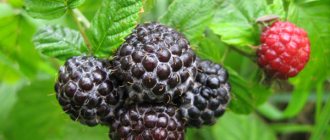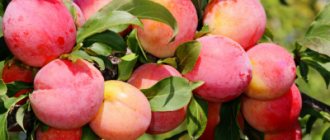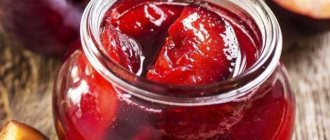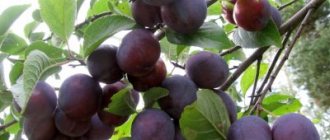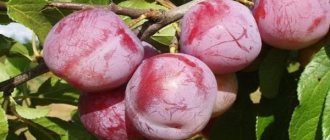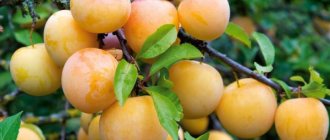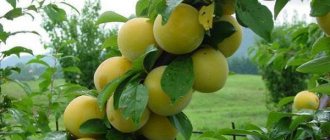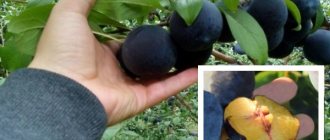History of variety selection
There is no exact information about the origin of the Prune variety. Most often, this name refers to damson. It was this that was obtained by crossing cherry plum with wild thorn. Sometimes there is information that Prunes were bred in 37 of the last century at the Maikop station. The result was a hybrid, but its parents are unknown. The variety was given the name Adyghe prune and included in the State Register in 1988. It is this culture that will be discussed further.
In everyday life, prunes are usually called dried plums that have been smoked. To obtain a popular product, the Stanley plum variety is most often used. The culture was developed by an American breeder in 26 of the last century. Stanley has been listed in the State Register since 1983.
Prunes are also made from the Hungarian plum, since its fruits lend themselves well to drying and are highly saturated with sugar. There are several varieties of Hungarian. The most common varieties are:
- Italian Hungarian is common in the southern regions. The heat-loving mid-season variety can freeze out in cold areas. The plum is self-fertile and does not require pollinators. The tree grows up to 5 m in height. The crown diameter is about 6 m. The plum does not tolerate drought, bears fruit 4 years after planting. Productivity reaches 50 kg per tree. Fruit weight is about 35 g.
- Domestic Hungarian bears fruit weighing 20 g. The plum variety Prune is late, heat-loving, and begins to bear fruit at the age of 7. The tree grows up to 6.5 m high. Productivity is about 150 kg.
- Hungarian Wangenheim is considered a frost-resistant crop. The plum variety Prunes is early, resistant to diseases, and thrives in poor soils. The yield of an adult tree reaches 60 kg, but the inflorescences require cross-pollination. Fruiting begins at the 6th year. The weight of the fruit reaches 30 g.
- Hungarian Korneevskaya is frost-resistant and drought-resistant. The variety is self-fertile. Pollinators are not needed. In terms of ripening period, the plum is mid-season. Fruiting begins after 6 years. At this time, the yield reaches 30 kg. Fruit weight is about 35 g.
The Renklod Karbysheva plum variety is well suited for the production of prunes. The tree is self-fertile and tolerates frost well. The weight of the fruit is about 40 g. The stone is easily separated from the pulp.
The mid-season variety Blue Bird is also used in the production of prunes. Fruiting of the seedling occurs in the third year from the moment of planting. The variety is self-fertile and resistant to frosty winters. The weight of the fruit is about 45 g. The stone is easily separated from the pulp.
You can dry prunes from the Izyum-erik plum variety. The culture is thermophilic, southern. The homeland of the mid-late variety is Crimea. Pollinators are required for fruiting. The yield of an adult tree reaches 115 kg. Fruit weight is about 10 g.
The plum Ural prune, which is also called Prune of the Urals, was bred from the cherry plum variety P-31. Another parent of the hybrid is the Ussuri plum. As a result, when crossing all varieties, the Ussuri plum produced a late prune, characterized by good frost resistance. The fruits grow of medium size, weighing no more than 16 g. The tree grows up to 2 m high. The variety is not self-fertile. The best pollinators are Ussuri plums and Ural red plums.
The video compares prunes with regular plum varieties:
How to cook prunes at home: video
The procedure for preparing prunes is much more complicated than freezing and requires more time and resources. If you do everything according to the technology (smoking, drying or drying), the result will be a tasty and healthy delicacy.
Important! For drying, you need to select whole, not overripe fruits, without damage, rot or wormholes.
.
Advice from experienced housewives will help you with this:
- When selecting quality plums, large specimens should be cut in half, and small ones can be dried whole. Please note that seedless fruits dry out faster. It is advisable to prepare fruits of the same size in one batch.
- After blanching, be sure to dry the fruit with a kitchen towel or napkin.
- In order for homemade prunes to acquire a more pronounced sweetness in taste and a specific shine, the plums are soaked in honey syrup during the harvesting process. It is prepared in a 1:2 ratio.
- To prevent juice from leaking out of the cut slices, place them with the cut side facing up.
- When using the oven, make sure that its temperature reaches at least +60...+80°C.
- Typically, the process of drying and smoking takes about 5 hours, drying - 10 hours. In order for the product to dry evenly, it is recommended to turn it over periodically.
- For better air circulation, leave the oven door ajar.
- When harvesting prunes naturally, dry them on hot sunny days away from roads and production plants. At night, be sure to put the tray in a warm, dry room.
- To prevent flies, wasps and other insects from landing on the plums, cover the tray with gauze.
- When the drying process is complete, place the product in a container with an airtight lid (preferably glass) and shake it daily to maintain a balance between dry and wet fruits. If condensation appears on the walls of the vessel, additional drying will be required.
Important! It is not advisable to eat plums and prunes at night because of their laxative effect.
Description of the plum variety Prunes
Now we will look at what the Prune plum looks like, which is widespread in households. The trees grow tall with a spreading crown. The average height of a plum is about 4 m. The length of the fruit branches does not exceed 50 cm. The plum produces large flower buds. The foliage grows slightly wrinkled. The leaf plate is strong and thick.
The fruits of the Prune variety are large, weighing from 40 to 45 g. The skin of the plum is dark blue, and when fully ripe it acquires a black tint. The fruit has a depression near the stalk and a vertical stripe running through the entire fruit. The shape of the plum is round or slightly elongated in the form of an oval. Despite the rough skin, the prune pulp is juicy and riddled with fiber. The bones separate well.
The Prune variety is suitable for growing in the middle zone. Numerous reviews from summer residents about prune plums in the Leningrad region indicate that the crop tolerates winters well. Due to the fact that the crop is self-fertile, a large harvest is guaranteed even in the absence of pollinators growing nearby.
Use of plums in cooking
Plum fruits are dried, pickled, felled, soaked and frozen. You can make juice, jam, preserves, jelly, liqueur, tincture and compote from them.
When making plum jam, be sure to remove the pit. Thanks to this, the jam can be stored for a long time. But, if you are going to eat the jam within a year, you don’t have to remove the pit.
Now you know about the benefits of prunes and how to grow this tree on your own plot. Do not forget about contraindications; before consuming the fruit, it is better to consult a doctor.
Characteristics of the variety
The Prune variety should not be confused with ordinary blue plums. To get to know the culture better, let's take a look at its characteristics.
Drought resistance, frost resistance
Prunes are considered a frost-resistant variety. Plum easily tolerates drought, but loves watering. In winter, fruit branches rarely freeze.
Plum pollinators Prunes
In terms of ripening time, Prunes are classified as mid-late varieties. Flowering begins in the spring along with the appearance of foliage. The plum is considered self-fertile, not requiring nearby pollinators to grow.
Productivity and fruiting
The variety is considered high-yielding. There may be rare interruptions in fruiting. A lot of fruit is set. The tree can shed excess plums.
Area of application of berries
The main area of application of Prune fruits is the production of dried fruits. About 22% of the finished product is obtained from fresh plums. Prunes are usually smoked. Fresh plums are used for preservation, they are used to make compote, jam, and make tinctures.
Resistance to diseases and pests
Plum is resistant to all fungal diseases. Pests such as aphids, sawflies, and scale insects can settle on the tree. Preventive spraying helps prevent crop destruction.
Advantages and disadvantages of the variety
Prunes have the following positive qualities:
- a self-fertile variety can be grown alone without necessarily planting a pollinator;
- abundant fruiting, high yield;
- plum adapts to the climatic conditions of the region and is not too demanding on the soil;
- the variety resists fungal diseases well;
- excellent winter hardiness allows you to grow plums in the middle zone, Leningrad region, Moscow region;
- The culture is drought resistant.
The only negative qualities that can be identified are the rough skin of the fruit and interruptions in fruiting.
What are prunes
Prunes have a pleasant aroma with a light, as if smoked smoke, sweet and sour taste, and dense marmalade pulp. Dried plums are used in hundreds of dishes and are considered iconic in North Africa, where they are added to festive tagines. Jews prepare the famous healthy tzimmes, a vegetable or fruit stew, with dried plums. In Norway they make their own national fruit soup. In the Dominican Republic, I love ice cream with prunes, and they also make amazingly delicious compotes, liqueurs, casseroles and many other dishes with it. Many people consider prunes to be a distant relative of the ordinary, familiar plum. But is it?
What is the difference between prunes and plums?
In fact, plums and prunes are the same thing. Prunes are dried, or rather dried plums, which are dried in the sun in a special way. At the same time, if you take thorn fruits, you won’t get tasty prunes - they will be sour. But the Hungarian and Renklod varieties, where the plums are especially fleshy, large, aromatic, honey-sweet, are suitable for making a healthy product.
The technologies for drying plums are also important; they differ significantly from one end to the other, affecting the taste, color, and appearance of prunes.
Appearance
The appearance of prunes depends on the technology of its preparation. To do this, take plums only picked from the tree. They are washed, lightly blanched in a weak soda solution, and then immediately washed with hot water. Then the plums are cooled and dried in the sun or in a special dryer. Drying, that is, withering, lasts no longer than 4 hours at a temperature of 40 degrees, and then the plums are kept warm for another two days at about 60 degrees. Shortly before the end of the process, the temperature is increased to 100 degrees, but only for a few minutes. This is how the plums caramelize, acquiring a characteristic dark shade. A little sugar appears on the skin of the plums, and the fruit acquires that slightly smoky taste for which everyone loves fruits.
A light white coating, also known as sugar, is evidence of healthy premium quality prunes.
Color and smell
A good prune is blue-black. Grayish with a glossy tint indicates that the plums have been treated with gases or glycerin after drying for a glossy shine and good presentation. However, the benefits of such plums are immeasurably less. By the way, many people like to buy pitted prunes - this makes dried fruit much more convenient to eat. But the most valuable are plums with pits, which you should take the trouble to remove before eating.
Origin
The best varieties of plums grow on the Adriatic coast, in the Eastern Caucasus, Asia Minor, and the Balkan Peninsula. There, plum trees are saturated with all the necessary substances from the soil and bear fruit with juicy, fleshy, very sweet fruits. It’s worth trying at least once dried plums, bought at the market in Tashkent or Yerevan, their taste and dense “nourishing” texture will be remembered for a long time. Today, dried fruits are imported on an industrial scale from Kyrgyzstan, Moldova, Argentina, Chile, Central America, and Ukraine. Producers in these countries have learned to produce high-quality, healthy, tasty dried plums.
Landing Features
You can grow prunes according to the same rules as ordinary plums. Let us consider in detail the nuances of agricultural technology.
Recommended timing
It is better to plant plum seedlings in early spring. In the southern regions, planting time falls in March. Gardeners in the middle zone and the Moscow region plant plums no later than the second ten days of April. It is advisable to prepare the hole in the fall or no earlier than two weeks before planting.
Important! Fans of autumn planting of fruit trees need to know that Prunes can be planted at this time of year, but only in the southern regions.
Choosing a suitable location
Plum Prunes like to grow in hot areas. The tree can be planted in any place where there are no drafts or waterlogged soil. The culture takes root well along buildings or fences.
Despite its drought tolerance, plums love moderately moist soil. If there is such an area in the yard, then you can safely plant a tree here.
Attention! If there is a lack of moisture, the yield will not decrease. Only the quality of the fruit will suffer. The plum pulp will not be juicy and sour.
Like any plum, Prune loves loose, light soil. When planting in clay or black soil, sand is added for looseness. High acidity of the soil also has a bad effect on the tree. The indicator is reduced by introducing lime into the soil. If there are high layers of groundwater on the site, the drain will not grow. Alternatively, you can try planting the seedling on a hill.
What crops can and cannot be planted nearby?
Plum loves solitude, but does not refuse proximity to other fruit trees. You cannot plant any type of currant, walnut, coniferous trees, or birch nearby. The pear is considered a bad neighbor. Plum is friendly with all other fruit trees, but the distance necessary for the development of roots and crowns must be maintained.
Selection and preparation of planting material
Prune seedlings can be taken from friends by digging up young shoots. However, planting material from the nursery is considered the best. The seedling can be sold with an open or closed root system. The last option is better in terms of survival rate. The main requirement for good seedlings is the presence of a developed large root, side branches, and living buds. The bark should be smooth without cracks or damage.
Advice! It is better to buy plum seedlings up to 1.5 m in height. Tall trees take root poorly and do not bear fruit for a long time.
Landing algorithm
For spring planting of plums, the hole is usually prepared in the fall. After plowing the land, the roots of weeds are removed from the site. A hole is dug up to 70 cm wide and deep. If the soil is heavy, the depth of the hole is increased by 15 cm. The added space is covered with a drainage layer of stone or gravel.
Fertile soil is mixed with manure or compost in a ratio of 1:2. The hole is filled with the prepared mixture and covered with insulation for the winter. In the spring, before planting Prunes, part of the soil is removed from the hole to accommodate the root of the seedling.
Important! When planting several plums, maintain a distance of at least 3 m between trees.
For a seedling with an open root system, a support stake is driven into the center of the hole. If the plum was purchased with closed roots, growing in a container, it is carefully removed and, together with a lump of earth, lowered into the hole. Such a seedling does not need a support stake. Backfilling is carried out with fertile soil previously removed from the pit. The seedling is watered, the tree trunk circle is mulched with peat.
Where and how to plant, growing prunes, proper care
For planting and growing, it is recommended to choose hot places protected from drafts.
In addition, when planting, it is important to consider that:
- It is recommended to plant seedlings in early spring. Holes for them can be prepared either in the fall or in the spring, several weeks before the actual planting. The depth of the pit should not be less than 45-50 cm, and in diameter 60-70 cm;
- The root neck of the tree should not fall below 3-5 cm from ground level. A plum planted too deeply grows more slowly and bears fruit worse;
- Loose soil with good breathability and normal acidity levels is best suited for planting;
- Before planting, it is recommended to mix the soil in the hole with humus in a ratio of two to one;
- The distance between rows of trees should not be less than 3 m, and between seedlings in a row 2.5 m.
It is important to remember that plums are very demanding when it comes to watering. The soil should not be allowed to dry out, especially during the formation of ovaries. However, it is recommended to stop watering a month before harvest.
Other care features that are important to remember include the need to cut out root shoots several times a year. If this is not done in time, the tree weakens and the yield level decreases.
The tree is resistant to temperature fluctuations and diseases and does not require special care other than regulating watering. If all the rules are followed, abundant fruiting is ensured.
Aftercare for plums
Immediately after planting, water the plum until the tree takes root well. Initially, pruning is done to help shape the crown. Subsequently, old and dry branches are removed. Prunes send out a lot of young shoots. It must be cut at least four times per season.
An adult tree is watered up to 6 times per season. Moisture is definitely needed after flowering, during ovary, at the end of harvesting, and in late autumn before wintering.
The video talks about spring feeding of plums:
The seedling initially has enough nutrients added during planting. In the second year, Prunes are fed with urea in early spring and June. From the third year of life, the first feeding is applied in early May. The plum is watered with a urea solution, dissolving 30 g of the drug in 10 liters of water. At the beginning of June, make a second feeding with a solution of 3 tbsp. l. nitrophoska and 8 liters of water. The last feeding of Prunes occurs at the beginning of August. The solution is prepared from 2 tbsp. l. potassium and superphosphate per 10 liters of water.
Rules for choosing prunes and storing them
Conscientious producers prepare prunes from ripe fruits that are well ripened and have accumulated maximum beneficial properties.
It is curious that after 30 days on the plum plantations, watering is stopped, so that the skin wrinkles a little. This plum condition is simply ideal for making prunes!
Ready-made, healthy and high-quality dried fruit is stored well for several months in a row and can be transported without problems. Another thing is that, for the sake of benefits, many treat them with substances that improve the appearance of fruits, or use plums with foulbrood and worms for drying. Learning to choose prunes correctly:
- We are looking for black fruits without splashes of red.
- The skin should be shiny, maybe with a light white coating.
- When pressed, the pulp should soften slightly without leaving any pits.
Store healthy dried fruits, prunes, in glass or cardboard jars with an airtight lid. Plastic containers are a little less suitable, however, for lack of anything better, you can use these containers. A good place to store prunes is the top shelf of the refrigerator or any cool, dry place.
Diseases and pests, methods of control and prevention
The plum variety is resistant to fungal infections, but if it occurs, the tree is sprayed with 1% Bordeaux mixture. Severe damage can only be eliminated with the systemic fungicide Hom. In case of manifestations of moniliosis, the plum is sprayed with the drug Skor.
It is important to carry out preventive treatment with pest control drugs. Aphids, scale insects, sawflies, and weevils can destroy the crop and the tree itself. In autumn, fallen fruits and leaves must be removed from the ground. Many pests overwinter in organic matter. In the spring they will move again to a healthy tree.
What are the benefits of prunes
In addition to its wonderful taste, it has a beneficial effect on the body. Used as a component of low-calorie dishes for weight loss or therapy.
Experts recommend consuming prunes for:
- Treatment of the oral cavity. Copes perfectly with bacteria, reduces their reproduction rate and numbers;
- Removal of bile in the presence of urolithiasis;
- Removing waste and toxins from the body;
- When taking a product such as prunes every day, there are benefits for those who want to lose weight;
- Prevention and treatment of diseases of the stomach and other organs of the digestive system. It is recommended to eat at least five berries per day, this helps normalize metabolic processes and intestinal contractile function;
- Prevention of the development of cancer;
- Stimulates brain function, the product replenishes the body’s energy reserves;
- Therapy of diseases of the cardiovascular system (hypertension, atherosclerosis, etc.);
- Improves vision, since drying is rich in keratin, which has a positive effect on the quality of vision.
Rich in vitamins and minerals, dried fruits are suitable for the treatment and prevention of many diseases. When taken systematically, it significantly reduces the risk of caries development.
The plum variety Prunes is distinguished by its high durability and taste. Used to make dried cakes rich in vitamins and minerals.
We learn more about one of the varieties of plums, Prunes, when watching the video:
An excellent variety of plum, I consider it one of the best and richest. A ripe plum separates perfectly from the stone and is amazing when dried. We stock up regularly and use it as food in the winter with meat.
- Login or register to leave comments
This variety pleases us primarily with its unpretentiousness and sufficient yield. I use it mostly fresh for food, I don’t dry it very much, occasionally I soak it in water in winter and just eat it as a dessert.
Preparation of dried fruits
Since the “Prunes” variety is excellent for drying and preparing its fruits, we should touch a little on the topic of preparing prunes for storage.
Description of the process of drying plum fruits.
- For drying and obtaining prunes, ripe fruits without signs of rotting or insect damage are selected.
- The plums are washed well in water and sorted by size.
- Next, the fruits are doused with boiling water. Additionally, it is recommended to immerse the plums in a one percent caustic soda solution for 20-30 seconds. This is done in order to get rid of a thin layer of wax on the skin of the fruit. However, drying is acceptable without this procedure.
- Drying of processed plums can be done in the sun, in an oven or in special electric drying cabinets. This process is carried out at a temperature of about 50°C for several hours. All this time it is necessary to visually monitor the condition of the fruit to prevent overdrying.
The pulp of the finished prunes is significantly reduced in volume, but remains soft and fleshy. It should easily separate from the pit.
You will see how to cook prunes at home in the next video.
Care instructions
It is important to know the following.
- Plum trees produce intensive root shoots. It should be uprooted or cut down at least 4 times per season. Young shoots significantly weaken the development of the tree and deplete the root system. This ultimately leads to a decrease in fruiting.
- During the active formation of ovaries, you should regularly loosen the root zone of the plant. It is important to ensure systematic watering during this period. Such measures will have a positive impact on the quantity and quality of the autumn harvest.
- Approximately a month before fruit ripening and harvesting, it is recommended to stop watering the trees.
- After harvesting the main harvest, excess plums should be removed from under the tree. Fruits should not be allowed to rot on the soil. This process is fraught with the development of pest microorganisms and fungal diseases of the fruit crop.
Plum varieties similar in quality and properties:
